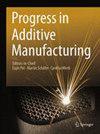金属浇铸入材料挤压3D打印制造的NaCl模具中
IF 5.4
Q2 ENGINEERING, MANUFACTURING
引用次数: 0
摘要
铝压铸是一种成熟的工业工艺,用于批量生产具有复杂形状的铝零件,但设计限制排除了一些特征,如凹口和空心结构,无法用这种方法生产。水溶性铸造模具为克服这些限制提供了一个很有前途的解决方案,例如通过热压盐芯或3D打印NaCl模具。目前,可用于NaCl的3D打印技术仅限于直接墨水书写(DIW)和光聚合。本研究提出了一种热塑性材料挤压(MEX) 3D打印制备NaCl零件的方法。首先,开发了一种可3D打印的原料,由有机粘合剂(通常用于陶瓷注塑成型)和氯化钠(NaCl)盐晶体组成。然后在颗粒式MEX打印机上打印各种模具。经过690℃的热脱脂和烧结后,3D打印部件由纯NaCl组成。此外,同样的NaCl原料用于注射成型。测量了经过后处理和未经过后处理的3D打印样品的抗弯强度,并与注塑测试样品进行了比较。最后,3D打印的NaCl模具中的金属铸件用锡或铝来展示,并且通过将NaCl模具溶解在水中来释放具有复杂几何形状的金属演示部件,例如陀螺结构和涡轮。本文章由计算机程序翻译,如有差异,请以英文原文为准。
Metal casting into NaCl molds fabricated by material extrusion 3D printing
Abstract Aluminum die casting is a well-established industrial process for mass producing aluminum parts with complex shapes, but design restrictions exclude some features like undercuts and hollow structures from being produced with this method. Water-soluble casting molds offer a promising solution to overcome those restrains, for example by hot pressing of salt cores or 3D printing of NaCl molds. Presently, 3D printing techniques available for NaCl are limited to direct ink writing (DIW) and photopolymerization. This study presents an approach to prepare NaCl parts by thermoplastic material extrusion (MEX) 3D printing. Firstly, a 3D printable feedstock is developed consisting of an organic binder, which is usually used for ceramic injection molding, and sodium chloride (NaCl) salt crystals. Various molds are then printed on a granulate-fed MEX printer. After thermal debinding and sintering at 690 °C, the 3D printed parts consist of pure NaCl. Furthermore, the same NaCl feedstock is used for injection molding. The bending strength of 3D printed samples with and without post-treatment are measured and compared to injection molded test specimens. Finally, metal casting in 3D printed NaCl molds is shown with tin or aluminum and the metal demonstrator parts with complex geometries such as gyroid structures and turbine wheels are released by dissolving the NaCl molds in water.
求助全文
通过发布文献求助,成功后即可免费获取论文全文。
去求助
来源期刊

Progress in Additive Manufacturing
Engineering-Industrial and Manufacturing Engineering
CiteScore
7.20
自引率
0.00%
发文量
113
期刊介绍:
Progress in Additive Manufacturing promotes highly scored scientific investigations from academia, government and industry R&D activities. The journal publishes the advances in the processing of different kinds of materials by well-established and new Additive Manufacturing (AM) technologies. Manuscripts showing the progress in the processing and development of multi-materials by hybrid additive manufacturing or by the combination of additive and subtractive manufacturing technologies are also welcome. Progress in Additive Manufacturing serves as a platform for scientists to contribute full papers as well as review articles and short communications analyzing aspects ranging from data processing (new design tools, data formats), simulation, materials (ceramic, metals, polymers, composites, biomaterials and multi-materials), microstructure development, new AM processes or combination of processes (e.g. additive and subtractive, hybrid, multi-steps), parameter and process optimization, new testing methods for AM parts and process monitoring. The journal welcomes manuscripts in several AM topics, including: • Design tools and data format • Material aspects and new developments • Multi-material and composites • Microstructure evolution of AM parts • Optimization of existing processes • Development of new techniques and processing strategies (combination subtractive and additive methods, hybrid processes) • Integration with conventional manufacturing techniques • Innovative applications of AM parts (for tooling, high temperature or high performance applications) • Process monitoring and non-destructive testing of AM parts • Speed-up strategies for AM processes • New test methods and special features of AM parts
 求助内容:
求助内容: 应助结果提醒方式:
应助结果提醒方式:


